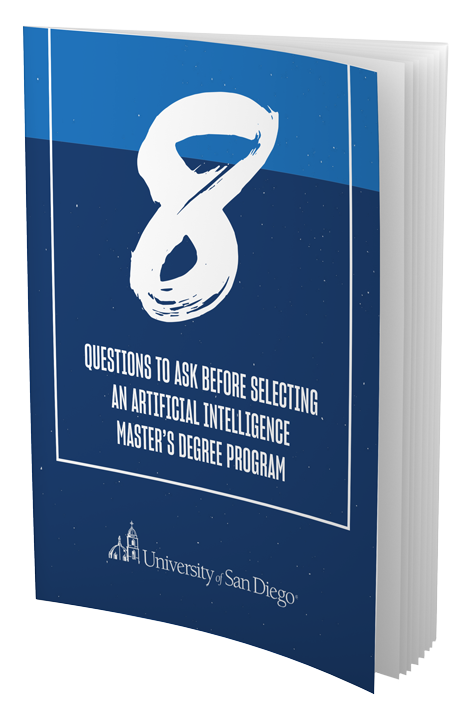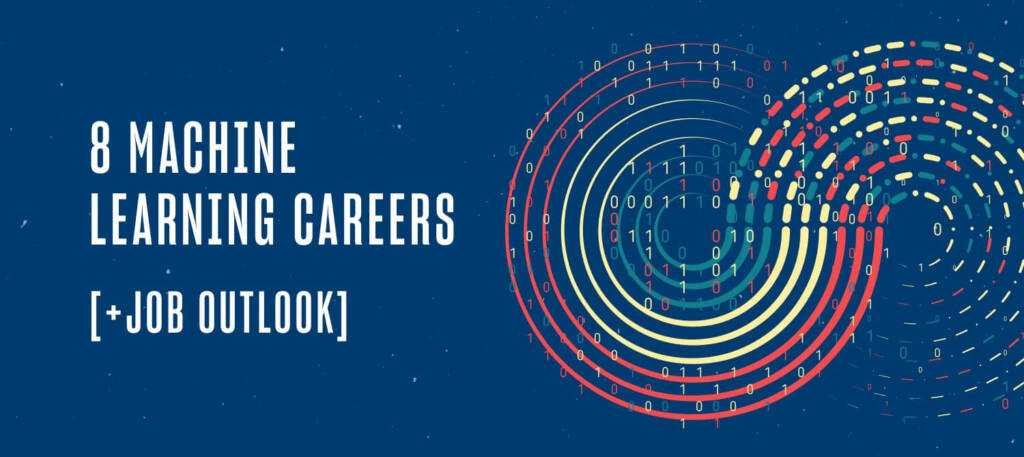Artificial intelligence is a lucrative, fast-paced field that is moving full steam ahead when it comes to job growth. In fact, positions related to AI and machine learning have grown by almost 75% within the last four years, which means it’s the perfect time to consider a job in artificial intelligence if you haven’t already.
Above all else — employers and hiring managers are looking for skilled professionals who have honed their AI skills and can bring a wealth of knowledge and experience to the table. And one way to achieve this is through an entry-level AI position.
AI Industry Overview — A Brief Snapshot
Whether you realize it or not, artificial intelligence has informed practically every type of industry — from healthcare and education to marketing, retail, eCommerce and financial services (just to name a few). Here are some important numbers to keep in mind:
- The number of artificial intelligence companies in the United States has doubled since 2017. As of 2022, there were almost 14,000 AI startups in the U.S.
- The AI market is expected to grow from $515.31 billion in 2023 to $2,025.12 billion by 2030.
Career Outlook for Entry-Level AI Jobs
The job outlook for all types of AI jobs, including entry-level ones, is extremely promising. According to Infosec, “the Bureau of Labor Statistics projects a 15% increase in computer and information research jobs from 2019-2029, including positions like AI specialists and machine learning engineers.”
Now let’s explore some common entry-level AI positions that can set you up for success in this exciting, innovative field. Note: Salary ranges will depend on a number of factors, including the position itself, location and required education; they will often fluctuate in real time due to changing data.
7 Common Entry-Level AI Jobs
1. Research Assistant
This may seem like a broad type of career — and it is. But research assistant positions in the artificial intelligence and machine learning sectors are a great way to learn valuable skills and gain much-needed experience. A person in this type of position may work at an academic institution or in a particular industry and is often responsible for assisting with AI- and machine learning-related research projects. Here are some examples of real-life research assistant responsibilities pulled directly from Indeed job postings:
- Help build the research community and contribute directly to a research program that creates and trains hierarchical neural networks (HNNs) in order to address the multiscale competence problem. Work toward natural robustness in neural networks, and create general re-usable neural modules that can be leveraged in future learning.
- Use machine learning approaches (e.g., natural language processing) to process clinical notes. Develop algorithms to pre-process the clinical data for development of machine learning pipelines. Develop machine learning pipelines to assist risk and outcomes prediction.
- Apply basic statistical knowledge; understand, interpret, and describe complex data by preparing graphs and tables.
- Provide research support for ongoing projects, including organizing project files, scheduling project activities and meetings, taking meeting minutes, and coordinating with co-investigators, collaborators, and project personnel across multiple sites to move projects forward.
- Maintain project databases, including tracking and reporting on project components to ensure timelines are adhered to and deadlines are met.
In most cases, research assistants need to have excellent communication skills and basic computer programming skills. Other skills pulled directly from real-life job postings include proficiency in coding and data science, competency in at least one ML framework, experience with Python, strong interest and experience in AI/ML and the ability to work on a team.
Salary range: For those with a year or less of experience, you can expect an average salary of $74,187 (with an additional $14,058 in commission, bonuses, etc. totaling a complete salary package of $88,245.)
Education needed: This will depend on the organization/company and type of position. For example, a graduate student may hold a research assistant position at an academic institution or company while obtaining an advanced degree. A postdoctoral student (also known as a “postdoc”) may also hold this type of job at a college or university.
Some research assistant positions may only require an associate or bachelor’s degree in a related field while others may require a master’s degree or Ph.D.
2. Junior Data Analyst
A data analyst is someone who translates numbers and data into words and graphic visualizations to help businesses and organizations understand how to make more informed business decisions. This junior position typically requires fewer hard skills and experience than a mid-level or senior data analyst. Junior data analyst responsibilities may include:
- Collecting and interpreting relevant data
- Using tools and algorithms to help organizations and companies understand different types of data
- Writing reports
- Creating relevant charts and graphics
Salary range: The average salary for a junior data analyst is around $59,197 with a range anywhere from $42,000 to $82,000.
Education needed: In most cases, a bachelor’s degree in statistics, computer programming, economics, accounting or related field is required. Some positions may require a master’s degree.
3. Junior Software Engineer
A software engineer develops software and systems for businesses and organizations and works with users to understand their software needs. Junior software engineer responsibilities may include helping mid- to senior-level engineers on projects, writing simple code, debugging existing software and assisting other team members. Example of real-life junior software engineering job descriptions include the following:
- Software protocol analysis, interacting with technical team members from multiple organizations in a team environment and providing engineering level documentation to enable testing and reporting.
- Software development, application integration, application troubleshooting, web development, database development, scripting and SaaS application configuration.
- Ability to write clear and maintainable source code and provide a thorough test suite demonstrating code correctness.
Salary range: The average salary for this position is around $77,904 with entry-level junior software engineers earning about $59,000.
Education: A bachelor’s degree in computer science, software engineering or a related discipline is recommended. Many employers also prefer candidates with programming language proficiency.
4. Information Systems Analyst
An entry-level Information Systems Analyst position is a good way to obtain necessary IT and cybersecurity experience and knowledge. In this position, you will help develop best practices, monitor security issues and track any problems or breaches and install software.
Example of real-life entry-level job descriptions include the following:
- Perform routine operational support, maintenance and system configuration as defined in departmental operating procedures.
- Identify, analyze and resolve data and system issues of low complexity.
- Participate in the development, validation and execution of test plans.
- Provide priority level one support for business systems.
- Participate in testing of new software releases or upgrades.
- Support system maintenance and upgrades throughout the product lifecycle.
- Identify and document defects and enhancements.
Salary range: For an entry-level position, expect a starting salary around $55,492; those with anywhere from 1–4 years of experience will earn around $60,938.
Education needed: In most cases, a bachelor’s degree in computer science, information technology, information systems or a related field is required.
5. Junior Programmer
Programmers in artificial intelligence are in high demand, so what better way to gain experience than through a junior-level position? Plus, programming skills are often required for other types of related jobs, which means this type of position will set you up for success in other AI career paths.
Responsibilities of a junior programmer include providing computer hardware maintenance, debugging software, writing programming guidelines and developing and maintaining applications and databases.
Salary range: The average salary is $53,282 with a range between $47,586 and $59,478.
Education needed: A bachelor’s degree in computer science or related field is usually required, in addition to knowledge and skills in software debugging, software design and programming languages.
6. Junior or Associate Data Scientist
Data science is an immersive, innovative and constantly-expanding field that includes multiple subdisciplines such as data analytics, data mining, artificial intelligence and machine learning. Typical data science responsibilities include using data to create impact for businesses and organizations by understanding a particular problem or challenge, engaging in data modeling and visualization and conducting exploratory analysis.
Examples from recent job postings include:
- Develop analytic models and products, application of methods for analysis requests in a manner that demonstrates understanding of and orientation against business value.
- Work content will be concentrated in the disciplines of forecasting and natural language processing.
- Work with other team members to research and develop tools and techniques to train and test machine learning algorithms.
- Work with other team members to design, build, modify, and implement software applications that apply machine learning methods.
- Use machine learning techniques to perform data analysis.
Salary range: The average salary for both an associate data scientist and junior data scientist is $92,560 with a range between $81,180 and $102,042.
Education needed: In this position, you will likely need a minimum of a bachelor’s degree in data science, computer science or a related field. Many jobs in this field, however, require an advanced degree.
7. Junior Software Developer
In this entry-level position, you will typically be asked to help write code and create different software designs. Additional responsibilities may include fixing bugs and collecting user data. This is a role that could easily lend itself to experience for an artificial intelligence developer position, which is ideal for those interested in AI, algorithms and computer programming.
Salary range: The average is $75,984 but the range for this position falls between $69,435 and $83,368.
Education needed: A bachelor’s degree in computer science is typically required, and basic programming experience is strongly recommended.
How to Gain Experience for Entry-Level Positions
You’ve probably noticed that even though these are entry-level AI positions, many require or highly recommend some type of prior experience or knowledge. The good news — there are a variety of ways to get there:
- Master’s degree programs: An advanced degree in either artificial intelligence or data science will prepare you with the right tools, knowledge and experience to handle any entry-level AI position. Plus, a graduate program often comes with numerous networking opportunities.
- Bootcamps: An AI bootcamp can be a fulfilling experience for anyone looking to gain knowledge and experience with experts in the field. A bootcamp can also be beneficial to students who are interested in a master’s degree by prepping them for a rigorous curriculum.
- Internships: A recent search for AI internships on LinkedIn revealed thousands of results, which means organizations and companies are looking for motivated individuals who are interested in starting a career in artificial intelligence.
If you’re interested in starting your artificial intelligence career, consider the University of San Diego’s Master of Science in Applied Artificial Intelligence. This innovative online program is an ideal way to obtain the experience and knowledge needed for many entry-level positions. If you’re interested in learning more, please reach out to one of our enrollment advisors.




